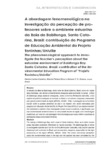Mostrar o rexistro simple do ítem
A abordagem fenomenológica na investigação da percepção de professores sobre o ambiente estuarino da Baía da Babitonga, Santa Catarina, Brasil: contribuição do Programa de Educação Ambiental do Projeto Toninhas/Univille
| dc.contributor.author | Lemke Carletto, Denise | |
| dc.contributor.author | Pereira Silva, Marcia | |
| dc.contributor.author | Guerra, Antonio F. S | |
| dc.date.accessioned | 2019-03-13T10:06:53Z | |
| dc.date.available | 2019-03-13T10:06:53Z | |
| dc.date.issued | 2015 | |
| dc.identifier.citation | Ambientalmente Sustentable, 2015, 20: 357-374. ISSN: 1887-2417 | es_ES |
| dc.identifier.issn | 1887-2417 | |
| dc.identifier.uri | http://hdl.handle.net/2183/22210 | |
| dc.description.abstract | [Resumo] O estuário da Baía da Babitonga, litoral norte de Santa Catarina, Brasil, como em outras áreas litorâneas, vem sendo constantemente ameaçada pelas atividades humanas. A Baía da Babitonga abriga espécies ameaçadas, como a toninha (Pontoporia blainvillei), única espécie de golfinho ameaçado de extinção no Brasil, e um extenso manguezal, responsável pela grande produtividade da região (BRASIL, IBAMA, 1998). A percepção da comunidade escolar sobre a questão ambiental da baía e da espécie vem sendo estimulada pelo programa de Educação Ambiental (EA) do Projeto Toninhas/UNIVILLE que objetiva também dar visibilidade à espécie. Essa investigação almeja buscar a essência, a significação, que esta biodiversidade ambiental exerce na comunidade escolar da região, com metodologias qualitativas, por meio de uma abordagem fenomenológica que busca refletir e expressar as percepções dessa comunidade litorânea | es_ES |
| dc.description.abstract | [Abstract] The estuary of Babitonga Bay, north coast of Santa Catarina, Brazil, as in other coastal areas, has been constantly threatened by human activities. The Babitonga Bay is home to endangered species such as the toninha (Pontoporia blainvillei), only dolphin species threatened with extinction in Brazil, and an extensive mangrove, responsible for the high productivity of the region (BRASIL, IBAMA, 1998). The school community perception about the environmental issue of the bay and the species has been stimulated by the Environmental Education Program of “Projeto Toninhas/UNIVILLE” which aims also give visibility to the species. The research aims to seek the essence, significance, that this environmental biodiversity has in the school community of the region with qualitative methodologies, through a phenomenological approach that seeks to reflect and express the perceptions of the seaside community. | es_ES |
| dc.language.iso | por | es_ES |
| dc.publisher | Universidade da Coruña, Servizo de Publicacións | es_ES |
| dc.rights | Atribución-CompartirIgual 3.0 España | es_ES |
| dc.rights.uri | http://creativecommons.org/licenses/by-sa/3.0/es/ | * |
| dc.subject | Fenomenología | es_ES |
| dc.subject | Percepção ambiental | es_ES |
| dc.subject | Educação ambiental | es_ES |
| dc.subject | Projeto Toninhas | es_ES |
| dc.subject | Baía da Babitonga | es_ES |
| dc.subject | Phenomenology | es_ES |
| dc.subject | Environmental perception | es_ES |
| dc.subject | Environmental education | es_ES |
| dc.subject | Babitonga Bay | es_ES |
| dc.title | A abordagem fenomenológica na investigação da percepção de professores sobre o ambiente estuarino da Baía da Babitonga, Santa Catarina, Brasil: contribuição do Programa de Educação Ambiental do Projeto Toninhas/Univille | es_ES |
| dc.title.alternative | The phenomenological approach to investigate the teacher’s perception about the estuarine environment of Babitonga Bay, Santa Catarina, Brazil: contribution of the environmental education program of “Projeto Toninhas/Univille” | es_ES |
| dc.type | info:eu-repo/semantics/article | es_ES |
| dc.rights.access | info:eu-repo/semantics/openAccess | es_ES |
| UDC.journalTitle | AmbientalMente Sustentable: Revista científica galego-lusófona de educación ambiental | es_ES |
| UDC.volume | 20 | es_ES |
| UDC.startPage | 327 | es_ES |
| UDC.endPage | 374 | es_ES |
| dc.identifier.doi | https://doi.org/10.17979/ams.2015.02.020.1614 |






